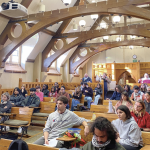Olivia Silvey ’25
Contributing Writer
Last Thursday, I sat down for my afternoon lecture, and my friend next to me started the conversation with: “Did you hear about the new COVID cases on campus?” I had not, and my stomach dropped. I felt that specific wave of COVID anxiety I haven’t felt since last school year, since Trinity has not had more than a few cases since the beginning of the semester. On Thursday morning, Chief of Staff and Associate Vice President for External Relations Jason Rojas sent an email explaining that there were eight positive student cases and three positive staff cases identified that week at Trinity. These recent cases were documented as students returning from Trinity Days, where everyone who was off campus for more than 24 hours was required to show a negative COVID test in order to return. While it was an annoying hoop to jump through, the College was able to identify the cases before school went back into full swing. This acted as a catch-all, which begs the question: why aren’t we testing regularly? Trinity should be testing all their students and staff on a weekly basis in order to catch COVID at the source just as they did after Trinity Days.
Currently, Trinity’s testing policy requires a random sampling of 10-15% of the vaccinated population to be tested every week, and the small percentage of unvaccinated students must be tested weekly. I’ve heard many complaints by students about the inconvenient times and long lines that the random testing brings. Sometimes, students don’t even come on their assigned date. If there was consistent testing, it would be easier for students to plan their schedules around their test, and the facilities would not be limited to a single trailer by Ferris.
Last year, Trinity required student testing twice a week, which now seems excessive with most of the population vaccinated; however, even testing everyone once a week would lift plenty of that COVID anxiety and act as a preventative measure, since college students will continue to hang out with friends and go to parties, obviously leaving masks at home. Just like the last 18 months have proved, it’s extremely hard to regulate young people’s social activities, especially when we are all on campus together.
Trinity has somewhat cracked down on large indoor social gatherings, like at Greek houses, and implemented mask wearing in public spaces like classrooms, dining halls, and the library. However, the damage is already done, even when Dean Trevor knocks on the door and tells everyone to disperse. It’s Trinity’s job to understand that at this point, one of the most effective ways of preventing the spread of COVID on campus is to make sure there aren’t any positive cases roaming Vernon Street on Saturday nights, since students will continue to find ways to socialize. COVID doesn’t evaporate because Campo shows up.
Other NESCAC schools such as Bowdoin, Colby and Bates have upped their testing game, and while they have more reported cases, their weekly testing is giving them the information they need to carry on safely. COVID is still a threat, but it’s not the same monster as it was last year – if we implement the right policies. Students and staff should be able to see their friends, go to class, and eat at Mather without the nervous voice in the back of their head asking, “am I putting myself at risk right now?” Trinity is lucky to still be on alert level green, and while we still have a low case rate, we need to be testing weekly to ensure that the school year stays as normal as possible. Trinity did it last year, and Trinity can do it again.


+ There are no comments
Add yours